
Kenneth Noland was an American painter. He was one of the best-known American color field painters, although in the 1950s he was thought of as an abstract expressionist and in the early 1960s he was thought of as a minimalist painter. Noland helped establish the Washington Color School movement. In 1977, he was honored by a major retrospective at the Solomon R. Guggenheim Museum in New York that then traveled to the Hirshhorn Museum and Sculpture Garden in Washington, D.C., and Ohio's Toledo Museum of Art in 1978. In 2006, Noland's Stripe Paintings were exhibited at the Tate in London.

The Hirshhorn Museum and Sculpture Garden is an art museum beside the National Mall in Washington, D.C., United States. The museum was initially endowed during the 1960s with the permanent art collection of Joseph H. Hirshhorn. It was designed by architect Gordon Bunshaft and is part of the Smithsonian Institution. It was conceived as the United States' museum of contemporary and modern art and currently focuses its collection-building and exhibition-planning mainly on the post–World War II period, with particular emphasis on art made during the last 50 years.
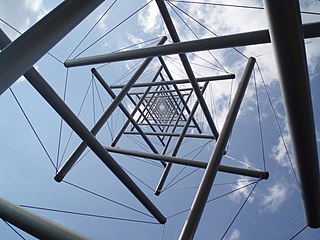
Kenneth Duane Snelson was an American contemporary sculptor and photographer. His sculptural works are composed of flexible and rigid components arranged according to the idea of 'tensegrity'. Snelson preferred the descriptive term floating compression.

The Burghers of Calais is a sculpture by Auguste Rodin in twelve original castings and numerous copies. It commemorates an event during the Hundred Years' War, when Calais, a French port on the English Channel, surrendered to the English after an eleven-month siege. The city commissioned Rodin to create the sculpture in 1884 and the work was completed in 1889.

Robert Gober is an American sculptor. His work is often related to domestic and familiar objects such as sinks, doors, and legs.

Sam Gilliam was an American color field painter and lyrical abstractionist artist. Gilliam was associated with the Washington Color School, a group of Washington, D.C.-area artists that developed a form of abstract art from color field painting in the 1950s and 1960s. His works have also been described as belonging to abstract expressionism and lyrical abstraction. He worked on stretched, draped and wrapped canvas, and added sculptural 3D elements. He was recognized as the first artist to introduce the idea of a draped, painted canvas hanging without stretcher bars around 1965. This was a major contribution to the Color Field School and has had a lasting impact on the contemporary art canon. Arne Glimcher, Gilliam's art dealer at Pace Gallery, wrote following his death that "His experiments with color and surface are right up there with the achievements of Rothko and Pollock."

Robert Engman was an American sculptor with works in the permanent collection of the Hirshhorn Museum, MOMA, the Whitney Museum of American Art, numerous college museums, and private collections.

Irene Rice Pereira was an American abstract artist, poet and philosopher who played a major role in the development of modernism in the United States. She is known for her work in the genres of geometric abstraction, abstract expressionism and lyrical abstraction, as well as her use of the principles of the Bauhaus school. Her paintings and writings were significantly influenced by the complex intellectual currents of the 20th century.

Edward Dugmore was an abstract expressionist painter with close ties to both the San Francisco and New York art worlds in the post-war era following World War II. Since 1950 he had more than two dozen solo exhibitions of his paintings in galleries across the United States. His paintings have been seen in hundreds of group exhibitions over the years.

Are Years What? is a sculpture by American artist Mark di Suvero. It is in the collection of the Hirshhorn Museum and Sculpture Garden, in Washington, D.C., United States. The sculpture is named after poet Marianne Moore's "What Are Years". From May 22, 2013 through May 26, 2014, the sculpture resided temporarily in San Francisco, as part of the San Francisco Museum of Modern Art's Mark di Suvero exhibition at Crissy Field.
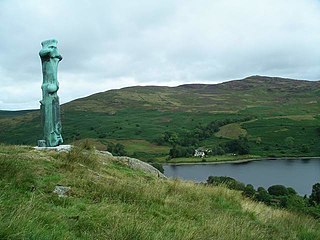
Upright Motive No. 1: Glenkiln Cross is a bronze sculpture by Henry Moore, cast in a number of copies in 1955–56. It was the first of a series of narrow vertical sculptures by Moore, who compared them to totem poles.
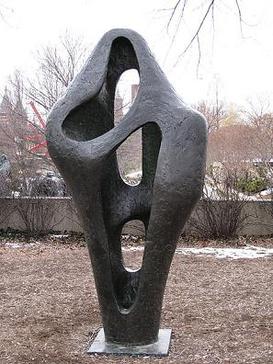
Figure for Landscape is a bronze sculpture by Barbara Hepworth, modeled in 1960.
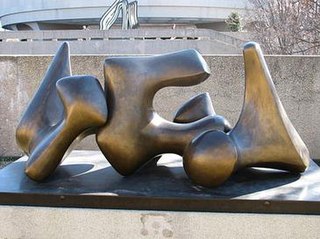
Three-Piece No. 3: Vertebrae is a bronze sculpture by Henry Moore. It was cast in 1968 as in edition of 8, along with an artist's copy which is now part of the Tate collection.

The Back Series is a series of four bas-relief sculptures, by Henri Matisse. They are Matisse's largest and most monumental sculptures. The plaster originals are housed in the Musée Matisse in Le Cateau-Cambrésis, France.
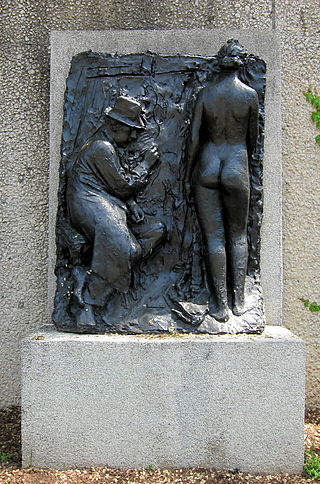
Self-Portrait with Model at Bergamo is a bronze sculpture by Giacomo Manzù, originally modeled in 1942. One cast, made by 1960, is located at the Hirshhorn Museum and Sculpture Garden of the Smithsonian Institution in Washington D.C..

Geometric Mouse, Variation I, Scale A is an abstract sculpture by Claes Oldenburg. created in 1971.
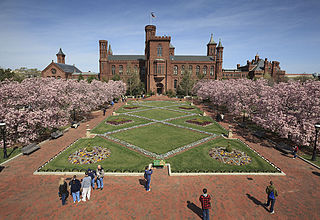
The Smithsonian Gardens, a division of the Smithsonian Institution, is responsible for the "landscapes, interiorscapes, and horticulture-related collections and exhibits", which serve as an outdoor extension of the Smithsonian's museums and learning spaces in Washington, D.C. Established in 1972 as a groundskeeping and horticulture program, Smithsonian Gardens currently manages 180 acres of gardens on the National Mall, 64,000 square feet of greenhouse production space, and the Archives of American Gardens, a research collection of over 60,000 photographs and archival records covering American landscape history from the 1870s to the present.
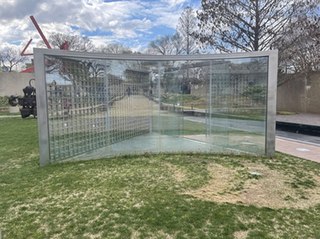
For Gordon Bunshaft is a 2006 sculpture by Dan Graham, installed at the Hirshhorn Museum and Sculpture Garden in Washington, D.C., United States. The work, which refers to American architect Gordon Bunshaft, was installed by the reflection pool of the Bunshaft-designed sculpture garden at the Hirshhorn on May 30, 2008.

Monumental Head is a 1960 bronze sculpture by Alberto Giacometti, installed at the Hirshhorn Museum and Sculpture Garden in Washington, D.C., in the United States. The abstract work measures 37 x 11 3/4 x 14 3/4 inches and depicts a roughly modeled head with an extended neck. Other casts of Monumental Head from this period are found in the collections of other institutions, including the Phillips Collection and the Los Angeles County Museum of Art.
















